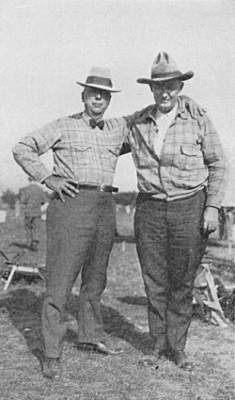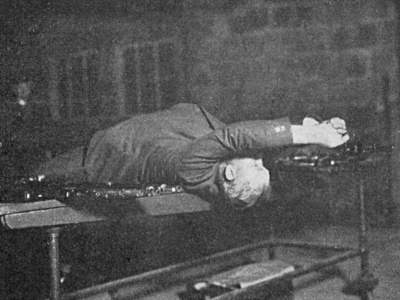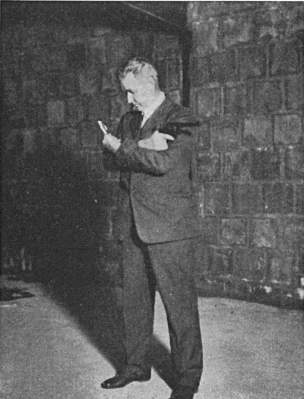The following information on trick and fancy shooting comes from Section 30 of Shooting by J. Henry FitzGerald. Shooting is also available to purchase in print.
Trick shooting is a very enjoyable branch of revolver shooting and when a fair degree of accuracy is attained your friends will enjoy it also, but when visiting the range for the first time to try out the flying objects it is just as well to leave the friends at home.
In this kind of shooting the favorite revolver is the Officer’s Model, six or seven and one-half inch barrel, with a medium-sized gold-bead front and U rear sight, such as is used by Captain Hardy, Mr. and Mrs. Topperwein, and others. The usual ammunition is mid-range sharp shoulder because of its light recoil and the clean-cut hole made by the sharp shoulder loads. We have had in the past a few who have resorted to shot cartridges but the nationally known fancy shot would not think of such a thing. His tricks are performed by skill only and not by any short cut.
The first thing to consider is a safe range where stray bullets will do no damage, and large targets, such as the much abused tomato can, should be used until they can be hit regularly. With an audience it is not so much the size of the object that counts but the hitting of it every time. As in other branches of shooting it is practice that makes perfect. When the old tomato can becomes easy to hit try smaller objects,—small cans, apples, blocks of wood, clay pigeons, glass balls, in fact anything of the required size. Avoid all fake shooting, such as small objects thrown at short range that may be broken by the powder blast. Practice real shooting.
I wish my old friend, Captain Hardy, were sitting here at my elbow while I am writing this section, for I know his suggestions would be of great value.

Fancy shooting is not all at flying objects. A very good start for an exhibition is made by laying on the back and breaking six candy wafers, crackers, or other small objects. The revolver will be reversed or upside down and twelve o’clock will be the aiming point instead of six o’clock as when the revolver is held in a normal position. The distance is twelve feet or more, governed by the size of the targets and ability to hit them. Stand in an upright position, lay the revolver in the palm of the right hand, sights to the right, and hold at nine o’clock to hit the objects; turn the hand over, sights to the left, and hold at three o’clock; do the same with the left hand.
Splitting a vertical card is a nice little trick and easily accomplished if the arm is properly sighted. The proper way to line a revolver up for this trick is to draw a line on a white paper and change sights until the arm is correctly centered to hit the line regularly at twelve feet; then try a horizontal line and correct the sights until you can regularly hit the cross where the lines meet. It is harder to hit the horizontal line than the vertical.
Hitting a swinging object is another pleasing shot. Some accomplish this at the end of the swing, but this is not as spectacular as hitting it when it passes the center. Try a small toy balloon hung by a string about five feet from the ground; cut the string with the first shot and hit the balloon before it reaches the ground. It falls slowly and there is plenty of time. Another trick is shooting two revolvers at two objects, both stationary or one stationary and one swinging.
I do not recommend shooting an object from the head of another or too close to the fingers. A revolver is not as accurate as a rifle for trick shooting, and a safe tolerance must be allowed. The Colt .22 caliber automatic pistol is very spectacular in fancy shooting due to its speed of fire, and the extreme accuracy of the arm makes it possible to hit wafers and other small objects in rapid succession.
Shooting at an empty eggshell held by an assistant, who puts on a rubber coat and cap, conveys the idea that the shell is full and this will always cause a laugh. One trick which should always be avoided is placing a cartridge head toward the shooter and exploding it by striking the primer with a bullet. I used this trick for years without trouble, until on one occasion the primer came back, cutting my cheek and embedding itself in the face of a man who stood behind me.
The trick of one man holding the revolver by the grip with a string passed through the trigger guard and resting on the trigger, passing one end of string over each shoulder to an assistant, the revolver is cocked and seemingly the assistant, who stands back to back with the shooter, fires the gun. But the real explanation is, the assistant holds the arms rigid while his companion with sights lined up on the object he wants to hit presses against the string until the shot is fired. This is a legitimate trick and must be practiced to perfect it.
Shooting at two tin cans ten or twelve yards apart, the shooter standing between the cans aiming a revolver at each can, seems very difficult, but it can be done by using the surest hand as the anchor, first glancing at this sight, then at the other, going back to the first hand, and noting if the sights still line up with the target. If they do, go back to the other revolver and squeeze both triggers at the same time. Cutting the spots out of playing cards may be done regularly at short range, and with a target on each side of an axe blade splitting a bullet on the edge of the axe is not as hard as it looks.
The novice should stand at a distance that will give him ninety per cent hits and increase the distance as his accuracy improves. Many original tricks may be worked out by the student of this work and in a short time an excellent exhibition may be given.
The idea of some people that a man who can hit a small object in the air must be a wonderful target shot is not true. The expert on flying objects will have to learn all over again when he tries for good scores, and the target man will encounter the same trouble when flying objects are substituted for the bull’s-eye. Then the man who is a ninety per cent shooter on flying objects will have his troubles when using the revolver on running game. Each man to his own particular line and if he wants to shoot them all, study them all.
I remember an incident which happened at Englewood (New Jersey) police range outdoors where I was giving an exhibition. A large oak tree grew on a bank about thirty-five yards away and fifty feet above the range level. This was in the autumn and the leaves were nearly all off the tree, and at just that instant a large oak leaf started from the top of the tree. I turned around and fired a shot at it as it was doing a perfect tailspin toward the ground. (This was the best shot I ever made and I couldn’t do it again in a week.) As the leaf flew in two pieces, cut clear across, some one called out, “Shoot the big piece.” I opened the revolver and threw three empty shells and three loaded ones in the bushes and imparted the information that my revolver was empty.

At another exhibition a fishhawk, flying so high that he looked about the size of a common house fly, attracted the attention of the audience. I was lying on my back breaking candy wafers at fifteen yards, so I fired a shot at him. Shortly afterward a fish about six inches long struck the ground a short distance from where I was lying and one of the audience ran and picked it up. In examining the fish he found where the large claws had pierced the side of the fish. He showed this to the astonished crowd and then called to me: “Say, Fitz, why didn’t you hit that hawk?” I answered: “What, and pay a fine of ten dollars?” I do not think I came within twenty feet of the hawk, but the report startled him into dropping the fish and the claw marks appeared about the size of the .22 caliber bullet that was used.
Long range shooting, one, two and three hundred yards, is an addition to the exhibition, but is not as spectacular as the short range work where something is broken. Two targets swinging are, of course, broken where they cross, timing the shot by the speed of the targets. Shooting with a looking-glass is accurate and very simple after the idea of lining up the sights is mastered. Many hits may be made in this manner and it is a very steady position due to the locked arms. The revolver held upside down may be used in connection with the mirror as it may be when shooting a revolver lying on the right or left side.

The .22 target revolver has not been mentioned in connection with this work, but it is a very accurate gun and dependable, besides being cheap to shoot. It is capable of performing as well as either of the others mentioned, and as to durability I have never been able to wear one out. The new heavy model, .22 caliber arms, Officer’s Model and Official Police, are wonders in trick shooting. These revolvers, or two revolvers, .38 and .22, and a .22 caliber automatic pistol, are enough for almost any kind of an exhibition, but if the urge for variety is felt add the .45 automatic Government Model to the collection and your audience will get a thrill out of the performance of the national arm and you will be agreeably surprised on your first trial.
Avoid shooting at bottles or glass of any kind, as the distance for sure hits is less than it is with a rifle, and some of the audience may be cut by the flying particles. The more equipment carried the more exciting the performance if hits are registered regularly. All stands and target holders should be neat and businesslike and of the folding variety. If the exhibitions are to be given in a hall light charge ammunition should be used and an adequate folding backstop added.
A good folding backstop is about eighteen inches square, using one-eighth inch steel for the back, one-sixteenth inch for the sides and one-eighth inch for the bottom. By using hinges this will fold up to about six inches in thickness by eighteen inches square. Heavy cardboard or heavier board should be used for the front and the same general construction as the larger backstop mentioned in the subject of Ranges. If a backstop of this kind is not at hand fill a wooden box eighteen inches square and twelve inches deep with dry sand. If portable backstop mentioned above is used, see that the hinges or joints are so placed that all corners are tight to prevent lead spattering out to mar the woodwork or furniture and place the backstop or sand-box on a stand about four feet high.
Shooting with the front sight covered by a piece of pasteboard at a medium sized target will add another trick to the collection and a little practice will show you how, both eyes open. Many pages have been written in the story books about hitting a can thrown in the air at a rise of ten or twelve feet six times before it strikes the ground, not drawing the arm until after the can is thrown. This trick will take some study and if you do not succeed, do not be discouraged; go back to your old tricks.
A small can held shoulder high and released, drawing the revolver from holster, and hitting said can before it hits the ground is always good. A small can or clay pigeon placed on the toe of the shoe and kicked in to the air, drawing from the holster and hitting it before it reaches the ground will get applause. Marbles, pennies, and empty shells hit regularly may close the exhibition to the satisfaction of all.
Some very good advice is to stay with one trick until it is perfected before going on to the next. Do not slight any of the tricks or become careless; the exhibition will suffer if this is done. Do not hurry the shots; take plenty of time and get results. Do not fire any shots that will endanger the life of any one and do not appear careless to the audience. An explanation of the different shots fired and a few remarks made at the right time will help in putting the tricks over.
